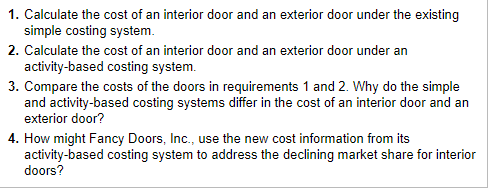1. Calculate the cost of an interior door and an exterior door under the existing simple costing system. 2. Calculate the cost of an interior door and an exterior door under an activity-based costing system. 3. Compare the costs of the doors in requirements 1 and 2. Why do the simple and activity-based costing systems differ in the cost of an interior door and an exterior door? 4. How might Fancy Doors, Inc., use the new cost information from its activity-based costing system to address the declining market share for interior doors?



Fancy Doors, Inc., produces two types of doors, interior and exterior. The company's simple costing system has two direct-cost categories (materials and labor) and one indirect-cost pool. The simple costing system allocates indirect costs on the basis of machine-hours. Recently, the owners of Fancy Doors have been concerned about a decline in the market share for their interior doors, usually their biggest seller. Information related to Fancy Doors production for the most recent year follows: E (Click the icon to view the production data.) (Click the icon to view additional information.) Read the requirements Requirement 1. Calculate the cost of an interior door and an exterior door under the existing simple costing system. Before calculating the cost of an interior and exterior door, begin by calculating the overhead rate under the simple costing system. First select the formula, then enter the applicable amounts and calculate the rate. (Round your answer to the nearest cent. Abbreviations used: bgt. = budgeted, qty = quantity.) Budgeted overhead rate Bgt. total costs in indirect cost pool Bgt. total qty of cost allocation base Simple costing system 1. Calculate the cost of an interior door and an exterior door under the existing simple costing system. 2. Calculate the cost of an interior door and an exterior door under an activity-based costing system. 3. Compare the costs of the doors in requirements 1 and 2. Why do the simple and activity-based costing systems differ in the cost of an interior door and an exterior door? 4. How might Fancy Doors, Inc., use the new cost information from its activity-based costing system to address the declining market share for interior doors? The owners have heard of other companies in the industry that are now using an activity-based costing system and are curious how an ABC system would affect their product costing decisions. After analyzing the indirect-cost pool for Fancy Doors, the owners identify six activities as generating indirect costs: production scheduling, material handling, machine setup, assembly, inspection, and marketing. Fancy Doors collected the following data related to the indirect-cost activities: Activity Activity Cost Activity-Cost Driver Production scheduling $ 96,200 Production runs Material handling $ 44,744 Material moves Machine setup $ 26,400 Machine setups Assembly $ 60,000 Machine-hours Inspection $ 19,200 Number of inspections Marketing costs were determined to be 2% of the sales revenue for each type of door. Fancy Doors, Inc., produces two types of doors, interior and exterior. The company's simple costing system has two direct-cost categories (materials and labor) and one indirect-cost pool. The simple costing system allocates indirect costs on the basis of machine-hours. Recently, the owners of Fancy Doors have been concerned about a decline in the market share for their interior doors, usually their biggest seller. Information related to Fancy Doors production for the most recent year follows: E (Click the icon to view the production data.) (Click the icon to view additional information.) Read the requirements Requirement 1. Calculate the cost of an interior door and an exterior door under the existing simple costing system. Before calculating the cost of an interior and exterior door, begin by calculating the overhead rate under the simple costing system. First select the formula, then enter the applicable amounts and calculate the rate. (Round your answer to the nearest cent. Abbreviations used: bgt. = budgeted, qty = quantity.) Budgeted overhead rate Bgt. total costs in indirect cost pool Bgt. total qty of cost allocation base Simple costing system 1. Calculate the cost of an interior door and an exterior door under the existing simple costing system. 2. Calculate the cost of an interior door and an exterior door under an activity-based costing system. 3. Compare the costs of the doors in requirements 1 and 2. Why do the simple and activity-based costing systems differ in the cost of an interior door and an exterior door? 4. How might Fancy Doors, Inc., use the new cost information from its activity-based costing system to address the declining market share for interior doors? The owners have heard of other companies in the industry that are now using an activity-based costing system and are curious how an ABC system would affect their product costing decisions. After analyzing the indirect-cost pool for Fancy Doors, the owners identify six activities as generating indirect costs: production scheduling, material handling, machine setup, assembly, inspection, and marketing. Fancy Doors collected the following data related to the indirect-cost activities: Activity Activity Cost Activity-Cost Driver Production scheduling $ 96,200 Production runs Material handling $ 44,744 Material moves Machine setup $ 26,400 Machine setups Assembly $ 60,000 Machine-hours Inspection $ 19,200 Number of inspections Marketing costs were determined to be 2% of the sales revenue for each type of door









